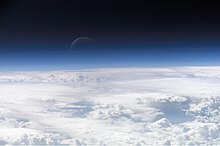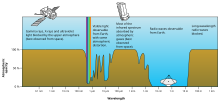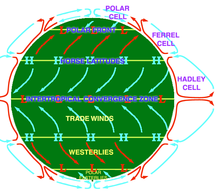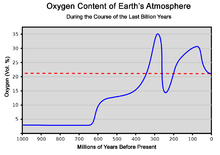| Revision as of 12:50, 13 September 2010 view source117.192.14.112 (talk) →Emission← Previous edit | Revision as of 12:51, 13 September 2010 view source 117.192.14.112 (talk) →CompositionNext edit → | ||
| Line 22: | Line 22: | ||
| !align = "left" | Gas | !align = "left" | Gas | ||
| !align = "left" |Volume | !align = "left" |Volume | ||
| |- | |||
| | ] (N<sub>2</sub>) || 780,840 ppmv (78.084%) | |||
| |- | |||
| | ] (O<sub>2</sub>) || 209,460 ppmv (20.946%) | |||
| |- | |||
| | ] (Ar) || 9,340 ppmv (0.9340%) | |||
| |- | |||
| | ] (CO<sub>2</sub>) || 390 ppmv (0.039%) | |||
| |- | |||
| | ] (Ne) || 18.18 ppmv (0.001818%) | |||
| |- | |||
| | ] (He) || 5.24 ppmv (0.000524%) | |||
| |- | |||
| | ] (CH<sub>4</sub>) || 1.79 ppmv (0.000179%) | |||
| |- | |||
| | ] (Kr) || 1.14 ppmv (0.000114%) | |||
| |- | |||
| | ] (H<sub>2</sub>) || 0.55 ppmv (0.000055%) | |||
| |- | |||
| | ] (N<sub>2</sub>O) || 0.3 ppmv (0.00003%) | |||
| |- | |||
| | ] (CO) || 0.1 ppmv (0.00001%) | |||
| |- | |||
| | ] (Xe) || 0.09 ppmv (9{{e|−6}}%) | |||
| |- | |||
| | ] (O<sub>3</sub>) || 0.0 to 0.07 ppmv (0% to 7{{e|−6}}%) | |||
| |- | |||
| | ] (NO<sub>2</sub>) || 0.02 ppmv (2{{e|−6}}%) | |||
| |- | |||
| | ] (I) || 0.01 ppmv (1{{e|−6}}%) | |||
| |- | |||
| | ] (NH<sub>3</sub>) || trace | |||
| |- | |||
| | Colspan=2 |'''Not included in above dry atmosphere:''' | |||
| |- | |||
| | ] (H<sub>2</sub>O) || ~0.40% over full atmosphere, typically 1%-4% at surface | |||
| |} | |||
| == Structure of the atmosphere == | == Structure of the atmosphere == | ||
Revision as of 12:51, 13 September 2010
"Air" redirects here. For other uses, see Air (disambiguation).

The atmosphere of Earth is a layer of gases surrounding the planet Earth that is retained by Earth's gravity. The atmosphere protects life on Earth by absorbing ultraviolet solar radiation, warming the surface through heat retention (greenhouse effect), and reducing temperature extremes between day and night. Dry air contains roughly (by volume) 78.09% nitrogen, 20.95% oxygen, 0.93% argon, 0.039% carbon dioxide, and small amounts of other gases. Air also contains a variable amount of water vapor, on average around 1%.
The atmosphere has a mass of about 5×10 kg, three quarters of which is within about 11 km (6.8 mi; 36,000 ft) of the surface. The atmosphere becomes thinner and thinner with increasing altitude, with no definite boundary between the atmosphere and outer space. An altitude of 120 km (75 mi) is where atmospheric effects become noticeable during atmospheric reentry of spacecraft. The Kármán line, at 100 km (62 mi), also is often regarded as the boundary between atmosphere and outer space.
Composition
Main article: Atmospheric chemistry

Air is mainly composed of nitrogen, oxygen, and argon, which together constitute the major gases of the atmosphere. The remaining gases are often referred to as trace gases, among which are the greenhouse gases such as water vapor, carbon dioxide, methane, nitrous oxide, and ozone. Filtered air includes trace amounts of many other chemical compounds. Many natural substances may be present in tiny amounts in an unfiltered air sample, including dust, pollen and spores, sea spray, and volcanic ash. Various industrial pollutants also may be present, such as chlorine (elementary or in compounds), fluorine compounds, elemental mercury, and sulfur compounds such as sulfur dioxide .
| ppmv: parts per million by volume (note: volume fraction is equal to mole fraction for ideal gas only, see Gas Volume) | ||||||||||||||||||||||||||||||||||||||||||||||||
| Gas | Volume
Structure of the atmospherePrincipal layers Earth's atmosphere can be divided into five main layers. These layers are mainly determined by whether temperature increases or decreases with altitude. From highest to lowest, these layers are:
Other layersWithin the five principal layers determined by temperature are several layers determined by other properties.
The average temperature of the atmosphere at the surface of Earth is 14 °C (57 °F; 287 K) or 15 °C (59 °F; 288 K), depending on the reference. Physical propertiesPressure and thicknessMain article: Atmospheric pressureThe average atmospheric pressure at sea level is about 1 atmosphere (atm) = 101.3 kPa (kilopascals) = 14.7 psi (pounds per square inch) = 760 torr = 29.9 inches of mercury (symbol Hg). Total atmospheric mass is 5.1480×10 kg (1.135×10 lb), about 2.5% less than would be inferred naively from the average sea level pressure and the Earth's area of 51007.2 megahectares, this defect having been displaced by the Earth's mountainous terrain. Atmospheric pressure is the total weight of the air above unit area at the point where the pressure is measured. Thus air pressure varies with location and time, because the amount of air above the Earth's surface varies. If atmospheric density were to remain constant with height the atmosphere would terminate abruptly at 8.50 km (27,900 ft). Instead, density decreases with height, dropping by 50% at an altitude of about 5.6 km (18,000 ft). As a result the pressure decrease is approximately exponential with height, so that pressure decreases by a factor of two approximately every 5.6 km (18,000 ft) and by a factor of e = 2.718… approximately every 7.64 km (25,100 ft), the latter being the average scale height of Earth's atmosphere below 70 km (43 mi; 230,000 ft). However, because of changes in temperature, average molecular weight, and gravity throughout the atmospheric column, the dependence of atmospheric pressure on altitude is modeled by separate equations for each of the layers listed above. Even in the exosphere, the atmosphere is still present. This can be seen by the effects of atmospheric drag on satellites. In summary, the equations of pressure by altitude in the above references can be used directly to estimate atmospheric thickness. However, the following published data are given for reference:
Density and mass The density of air at sea level is about 1.2 kg/m (1.2 g/L). Density is not measured directly but is calculated from measurements of temperature, pressure and humidity using the equation of state for air (a form of the ideal gas law). Atmospheric density decreases as the altitude increases. This variation can be approximately modeled using the barometric formula. More sophisticated models are used to predict orbital decay of satellites. The average mass of the atmosphere is about 5 quadrillion (5×10) tonnes or 1/1,200,000 the mass of Earth. According to the National Center for Atmospheric Research, "The total mean mass of the atmosphere is 5.1480×10 kg with an annual range due to water vapor of 1.2 or 1.5×10 kg depending on whether surface pressure or water vapor data are used; somewhat smaller than the previous estimate. The mean mass of water vapor is estimated as 1.27×10 kg and the dry air mass as 5.1352 ±0.0003×10 kg." Optical propertiesSee also: SunlightSolar radiation (or sunlight) is the energy the Earth receives from the Sun. The Earth also emits radiation back into space, but at longer wavelengths that we cannot see. Part of the incoming and emitted radiation is absorbed or reflected by the atmosphere. ScatteringMain article: ScatteringWhen light passes through our atmosphere, photons interact with it through scattering. If the light does not interact with the atmosphere, it is called direct radiation and is what you see if you were to look directly at the Sun. Indirect radiation is light that has been scattered in the atmosphere. For example, on an overcast day when you cannot see your shadow there is no direct radiation reaching you, it has all been scattered. As another example, due to a phenomenon called Rayleigh scattering, shorter (blue) wavelengths scatter more easily than longer (red) wavelengths. This is why the sky looks blue, you are seeing scattered blue light. This is also why sunsets are red. Because the Sun is close to the horizon, the Sun's rays pass through more atmosphere than normal to reach your eye. Much of the blue light has been scattered out, leaving the red light in a sunset. AbsorptionMain article: Absorption (electromagnetic radiation)Different molecules absorb different wavelengths of radiation. For example, O2 and O3 absorb almost all wavelengths shorter than 300 nanometers. Water (H2O) absorbs many wavelengths above 700 nm. When a molecule absorbs a photon, it increases the energy of the molecule. We can think of this as heating the atmosphere, but the atmosphere also cools by emitting radiation, as discussed below.  The combined absorption spectra of the gases in the atmosphere leave "windows" of low opacity, allowing the transmission of only certain bands of light. The optical window runs from around 300 nm (ultraviolet-C) up into the range humans can see, the visible spectrum (commonly called light), at roughly 400–700 nm and continues to the infrared to around 1100 nm. There are also infrared and radio windows that transmit some infrared and radio waves at longer wavelengths. For example, the radio window runs from about one centimeter to about eleven-meter waves.
Because of its temperature, the atmosphere emits infrared radiation. For example, on clear nights the Earth's surface cools down faster than on cloudy nights. This is because clouds (H2O) are strong absorbers and emitters of infrared radiation. This is also why it becomes colder at night at higher elevations. The atmosphere acts as a "blanket" to limit the amount of radiation the Earth loses into space. The greenhouse effect is directly related to this absorption and emission (or "blanket") effect. Some chemicals in the atmosphere absorb and emit infrared radiation, but do not interact with sunlight in the visible spectrum. Common examples of these chemicals are CO2 and H2O. If there are too much of these greenhouse gases, sunlight heats the Earth's surface, but the gases block the infrared radiation from exiting back to space. This imbalance causes the Earth to warm, and thus climate change. Refractive indexThe refractive index of air is close to, but just greater than 1. Systematic variations in refractive index can lead to the bending of light rays over long optical paths. One example is that, under some circumstances, observers onboard ships can see other vessels just over the horizon because light is refracted in the same direction as the curvature of the Earth's surface. The refractive index of air depends on temperature, giving rise to refraction effects when the temperature gradient is large. An example of such effects is the mirage.
CirculationMain article: Atmospheric circulation Atmospheric circulation is the large-scale movement of air, and the means (with ocean circulation) by which heat is distributed around the Earth. The large-scale structure of the atmospheric circulation varies from year to year, but the basic structure remains fairly constant as it is determined by the Earth's rotation rate and the difference in solar radiation between the equator and poles. Evolution of Earth's atmosphereSee also: History of Earth, Gaia hypothesis, and PaleoclimatologySecond atmosphereWater related sediments have been found dating from as early as 3.8 billion years ago. About 3.4 billion years ago, nitrogen was the major part of the then stable "second atmosphere." An influence of life has to be taken into account rather soon in the history of the atmosphere, since hints of early life forms are to be found as early as 3.5 billion years ago. The fact that this is not perfectly in line with the - compared to today 30% lower - solar radiance of the early Sun has been described as the "Faint young Sun paradox". The geological record however shows a continually relatively warm surface during the complete early temperature record of the Earth with the exception of one cold glacial phase about 2.4 billion years ago. In the late Archaean era an oxygen-containing atmosphere began to develop, apparently from photosynthesizing algae which have been found as stromatolite fossils from 2.7 billion years ago. The early basic carbon isotopy (isotope ratio proportions) is very much in line with what is found today, suggesting that the fundamental features of the carbon cycle were established as early as 4 billion years ago. Third atmosphere The accretion of continents about 3.5 billion years ago added plate tectonics, constantly rearranging the continents and also shaping long-term climate evolution by allowing the transfer of carbon dioxide to large land-based carbonate storages. Free oxygen did not exist until about 1.7 billion years ago and this can be seen with the development of the red beds and the end of the banded iron formations. This signifies a shift from a reducing atmosphere to an oxidising atmosphere. O2 showed major ups and downs until reaching a steady state of more than 15%. The following time span was the Phanerozoic era, during which oxygen-breathing metazoan life forms began to appear. Currently, anthropogenic greenhouse gases are increasing in the atmosphere. According to the Intergovernmental Panel on Climate Change, this increase is the main cause of global warming. Air pollutionMain article: Air pollutionAir pollution is the human introduction of chemicals, particulate matter, or biological materials that cause harm or discomfort to organisms into the atmosphere. Stratospheric ozone depletion is believed to be caused by air pollution (chiefly from chlorofluorocarbons). See also
References
External links
| |||||||||||||||||||||||||||||||||||||||||||||||
|---|---|---|---|---|---|---|---|---|---|---|---|---|---|---|---|---|---|---|---|---|---|---|---|---|---|---|---|---|---|---|---|---|---|---|---|---|---|---|---|---|---|---|---|---|---|---|---|---|
